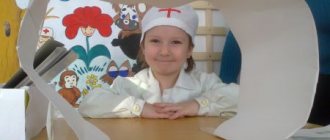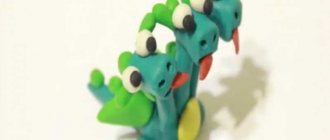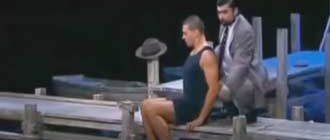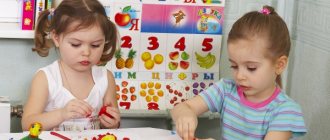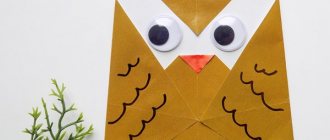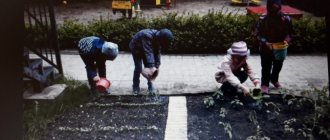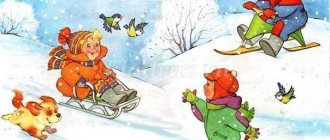Observations of Dachshunds at home
In principle , I have been monitoring the dachshund for a very long time , since she appeared in our house as a small puppy at the age of two weeks.
Our family spent a long time choosing her nickname and finally named her
Dusya . And then a second dachshund, Marusya, - Dusya’s daughter.
They have fun together in our house, they live peacefully. A dachshund puppy doesn't look much like a dachshund. A big belly on short legs, a small face, a hooked nose. At first, while our dachshunds were puppies, we fed them milk and special canned food for puppies.
When they grew up a little, they began to eat cooked food - various porridges made from buckwheat, pearl barley and other cereals. They didn't like the dry food advertised on TV. Most of all they love buckwheat porridge with pieces of liver. But of course, my favorite delicacy is a bone with meat.
Since the dachshund has a natural and irresistible desire to chew on everything that is of some dog interest to it, we now buy two dogs, in addition to toys, special bones. They chew them with great joy.
They often beg for something tasty, especially when they see us eating something. And if you leave food on the table, they can steal a piece while no one is looking. Therefore, you cannot leave food on the table unattended. At first we fed our dachshunds three or four times a day, then when they grew up - twice a day, but now they only have enough to eat once a day, and this does not reduce their energy for playing.
Our dachshund dogs somehow immediately learned to go to the toilet in one place, which was prepared for them in the bathroom. Probably because dachshunds are very smart, clean dogs. During the day and evening, they “beg” - they whine, run up and bark quietly to be taken outside.
Dachshunds have a lot of energy and love to play. The best entertainment for dachshunds is “chasing” and “catching up”. My sister and I often play with them. However, when playing with a dachshund, you need to be careful not to harm the dog's health.
The dachshund is a very loyal dog that loves its owners very much. Our dachshund dogs always enthusiastically greet us when we return from school or work. For joy, they begin to spin and jump, trying to crawl under his arms to be greeted and praised, since they were at home alone and guarded him.
Conclusion
The Dachshund is one of the most beloved breeds around the world. Despite the vagaries of fashion, which, unfortunately, also applies to dogs, the dachshund has been one of the most popular breeds for more than a century.
The dachshund can rightfully be called the most original of all breeds of hunting dogs - quite small in stature and at the same time considerable weight, elongated body and well-coordinated, harmonious movements and, finally, a voice that would be the envy of a larger dog, and teeth and fangs, like all beast dogs are worthy of respect.
Advantages – the dachshund is usually attentive, affectionate and sociable. She has a stable, balanced nervous system, characteristic of dogs of a strong type. The properties of her character, as well as her hunting qualities, provide her with constant sympathy and love. Some people who have never owned a dachshund or interacted with one directly say about these dogs: “I heard that these are the smartest dogs!”
This is probably one of the very rare cases when a rumor can be trusted, when it gives an absolutely correct description of the mental abilities of a dachshund. It is not for nothing that at the beginning of the century Anton Pavlovich Chekhov said about a dog of this breed: “The paws are crooked, the bodies are long, but the mind is extraordinary.” In my opinion, this says it all, this is quite enough to form a first impression about the Dachshund breed. If you decide to purchase a Dachshund, then you need to immediately take into account the risk that everything that comes into his mouth will be tested.
Although it is impossible to remove absolutely all the “forbidden fruits” that excite the dachshund’s imagination, over time it is necessary to begin to instill in the dog a respectful attitude towards the home interior. Therefore, you need to be prepared for the fact that until approximately 8-9 months of age, the puppy will still try to drag something away and chew on it. Many of those who kept dogs of other breeds in their home, but once got a dachshund, will never change it again.
| No. | Parameter | Data | Data |
| 1 | Name | Dusya | Marusya |
| 2 | Color | Black | Redhead |
| 3 | Breed | Dachshund | Dachshund |
| 4 | Age | 6 years | 3 years |
| 5 | Weight | 12 kg | 9 kg |
| 6 | Length | 60cm | 56cm |
| 7 | Temperature | 37,5 | 38,7 |
| 8 | Number of teeth | 42 | 42 |
| 9 | Number of fingers | Front 5, rear - 4 | Front 5, rear - 4 |
References
1. Dachshunds. Story. Exterior. Standards. Tests of Muromtsev M. Year of publication: 2008 Publisher: Aquarium
2. Dachshund Rishina N. Year of publication: 2009 Publisher: Zhuk
3. Dachshund. Standard. Content. Upbringing. Prevention of diseases. Exhibitions Kurt Schmidt-Duisberg Year of publication: 2012 Publisher: Aquarium-Print Series: Pets
4. Dachshund - L.A. Malyshev, I.A. Frolova - publishing house "Kolos" 1993
Visual inspection
The initial examination begins the moment the veterinarian enters the examination room. The initial examination includes an assessment of the animal's health, body position, gait and behavior. It is advisable that during the inspection the animal is off-leash and off-leash, this provides greater freedom of movement and will allow the animal to remain calm.
First of all, the behavior of the animal is assessed. Healthy puppies and kittens are usually inquisitive and active. Passivity and indifference of an animal may indicate its illness. Such a serious disease as portosystemic shunt is often accompanied by lethargy of the animal and stunted growth. A pet's blindness may not be noticeable at home, in its familiar surroundings, but in an unfamiliar room, a kitten or puppy will bump into furniture or walls.
During the examination, the veterinarian pays attention to the animal’s breathing. Smooth, deep, rhythmic breathing is characteristic of a healthy animal. Hoarse sounds, wheezing, difficulty breathing, shallow breathing, or shortness of breath may indicate a medical condition.
The veterinarian will evaluate the animal's body size, overall proportions and posture. Certain characteristics of your pet's posture may indicate pain they are experiencing. Features of growth and development will allow you to assess the likelihood of the presence of genetic abnormalities or developmental features of the animal.
A careful examination will allow the veterinarian to assess the general condition of the animal’s body and the volume of muscle mass. Being overweight or underweight may indicate a medical condition, poor diet, or lack of exercise.
To better assess the animal's gait, the veterinarian may ask the dog's owner to walk with the dog in front of the doctor. This will allow lameness to be identified and localized. A cat's gait can be more difficult to assess.
After certain elements of the initial examination have been completed, the patient may be weighed. Weighing is usually not performed at the beginning of the examination so that all external manifestations of a possible disease, such as breathing, do not change as a result of the stress of the animal's contact with the doctor.
Palpation of the animal should cover it entirely, from the tip of the nose to the tip of the tail. Some cats have a negative attitude towards detailed examination, which makes palpation much more difficult. However, the general rule for all cats is that the veterinarian strives to handle cats as little as possible.
Initial physical examination
(c) Veterinary center for the treatment and rehabilitation of animals “Zoostatus”.
Varshavskoe highway, 125 building 1.
The initial (physical) examination of cats and dogs consists of several mandatory steps. The order in which they are performed may vary.
The entire course and all results of the examination must be recorded in the animal’s medical record. The usual entry “Healthy” or “No pathology detected” is not enough. A detailed description of the initial inspection will ensure that any irregularities are identified during the inspection process.
The initial examination consists of visual examination and physical examination (palpation). The doctor uses all his senses - sight, hearing, smell, touch - throughout the examination.
Head and neck examination
First, your veterinarian will evaluate the shape and symmetry of the skull. Each eye will be examined, its position, the reaction of the pupil to light. If necessary, pharmacological drugs can be used to dilate the pupil.
Then the ears are examined. The animal's ear should be sensitive to soft sounds and light touch. The ears are examined inside and out, then an otoscope is used to examine the ear canal.
The shape and symmetry of the nose is carefully assessed by the doctor. The color of the mucous membranes, the presence of damage or discharge are studied. The nostrils are examined.
To examine the oral cavity, you need to open the animal's mouth. Resistance to examination may indicate tenderness and indicate disease. The doctor will examine the color and condition of the mucous membranes, and check the condition of the gums and palate. Assess the condition of the teeth, bite, and the presence of tartar.
The veterinarian will palpate the lymph nodes and check the condition of the trachea down to the chest. Assessing neck mobility by gentle rotation and rotation will identify areas of pain (if any) or difficulty moving.
Rectal examination
The veterinarian will take the animal's rectal temperature. Normal rectal temperature in dogs is 37.8 – 39.1 °C, in cats 38 – 39.1 °C.
Then palpation and rectal examination of the rectum and vagina (in females) are performed. The condition of the anal glands is diagnosed. The animal's feces are examined.
Read reviews about our veterinary center. Call the number and schedule a consultation right now or request a call back. (c) Veterinary center for the treatment and rehabilitation of animals “Zoostatus”. Varshavskoe highway, 125 building 1.
Source
